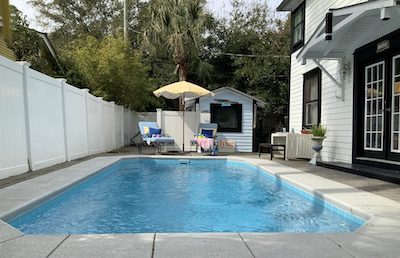Bike and pedestrian trail on Tybee to offer a "millionaire view".
Tybee cleared to construct new trail north of U.S. 80
By KELLY QUIMBY SAVANNAH NOW
Just off U.S. 80 on Tybee Island’s north end, an old railroad bed hides behind the overgrowth between the highway, the salt marsh and, further out, the Savannah River.
Right now, the dirt path is used by Georgia Power as a utility and maintenance easement. But state officials recently signed off on a Coastal Marshlands Protection Act permit that will allow island officials to re-purpose the trail into a bike and pedestrian path.
The unanimous approval from the Coastal Marshlands Protection Committee on April 17 cleared one of the last remaining obstacles in the way of Tybee Island’s Marsh Hen Trail project. Within the year, city officials hope to get started on a trail that will offer “a millionaire view for the common man,” said Tybee Island City Manager Diane Schleicher.
“We’ll create a way for (users of the trail) to appreciate that environment,” Schleicher said. “I’m all about that connectivity and education. Once people see this trail, they’ll say ‘Why didn’t we do this sooner?’”
According to the notification for the project published by the Georgia Department of Natural Resources, the new trail will cover more than 5 acres — about a linear mile — of which more than 2 acres will be marshlands. Where the trail meets the marsh, Tybee officials will build eight elevated boardwalks.
While more expensive, the pilings used to hold up the bridges will be a less invasive option than filling in the marsh, Schleicher said.
The plan is to include interpretive signs to inform visitors about the natural and historical aspects of the trail, in addition to restroom facilities and picnic tables. The result, Councilman Paul Wolff said, will be “a whole new experience for people on Tybee.”
“What we’re trying to do is connect the McQueen’s Trail that runs from Bull River to Fort Pulaski to the beach at East Gate on Tybee,” Wolff said. “This has been a long-term goal of a lot of folks on Tybee. It would be an enhancement not only for residents but tourists who want to see more of the island on a bicycle.”
Schleicher said the project is estimated to cost $427,982.64. The city will pay most of it — $329,162 — in grant funding. Tybee will pay its local match out of special purpose local option sales tax proceeds.
Wolff said this phase of the project will run from Byers Avenue to the end of Battery Row, stopping short of the Lazaretto Creek Bridge. The plan is to extend the path over the bridge once it’s rebuilt with a barrier to protect bicyclists.
Right now, the dirt path is used by Georgia Power as a utility and maintenance easement. But state officials recently signed off on a Coastal Marshlands Protection Act permit that will allow island officials to re-purpose the trail into a bike and pedestrian path.
The unanimous approval from the Coastal Marshlands Protection Committee on April 17 cleared one of the last remaining obstacles in the way of Tybee Island’s Marsh Hen Trail project. Within the year, city officials hope to get started on a trail that will offer “a millionaire view for the common man,” said Tybee Island City Manager Diane Schleicher.
“We’ll create a way for (users of the trail) to appreciate that environment,” Schleicher said. “I’m all about that connectivity and education. Once people see this trail, they’ll say ‘Why didn’t we do this sooner?’”
According to the notification for the project published by the Georgia Department of Natural Resources, the new trail will cover more than 5 acres — about a linear mile — of which more than 2 acres will be marshlands. Where the trail meets the marsh, Tybee officials will build eight elevated boardwalks.
While more expensive, the pilings used to hold up the bridges will be a less invasive option than filling in the marsh, Schleicher said.
The plan is to include interpretive signs to inform visitors about the natural and historical aspects of the trail, in addition to restroom facilities and picnic tables. The result, Councilman Paul Wolff said, will be “a whole new experience for people on Tybee.”
“What we’re trying to do is connect the McQueen’s Trail that runs from Bull River to Fort Pulaski to the beach at East Gate on Tybee,” Wolff said. “This has been a long-term goal of a lot of folks on Tybee. It would be an enhancement not only for residents but tourists who want to see more of the island on a bicycle.”
Schleicher said the project is estimated to cost $427,982.64. The city will pay most of it — $329,162 — in grant funding. Tybee will pay its local match out of special purpose local option sales tax proceeds.
Wolff said this phase of the project will run from Byers Avenue to the end of Battery Row, stopping short of the Lazaretto Creek Bridge. The plan is to extend the path over the bridge once it’s rebuilt with a barrier to protect bicyclists.



